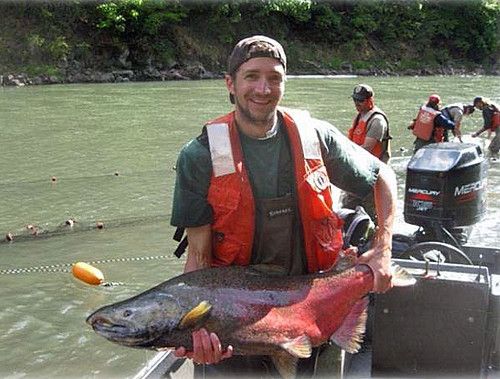
Dubbed America’s premier alpine whitewater river, the White Salmon River in south central Washington State was recently named as a top destination by the New York Times.
The White Salmon, used by kayakers and rafters all year round, winds nearly 45 miles from its headwaters on the Gifford Pinchot National Forest through steep, forested canyons into the Columbia River Gorge National Scenic Area and the Columbia River.
The clear, blue waters and unique beauty draw visitors to the river as well as giving some of them an opportunity for an exciting ride. Designated as a Wild and Scenic River on 29 miles of its length, continuous class I (easy), II (medium), and III (difficult) rapids with an occasional class IV (very difficult) keep boaters on their toes. The river is one of 119 wild and scenic rivers managed by the Forest Service.
For 100 years the upper reaches of the White Salmon were blocked to fish by the 125-foot high Condit Dam. In 2011, the removal of the dam started and this year the final obstructions on the river were taken out.
Removal of the dam opened new spawning and rearing grounds for salmon and to steelhead, a sea-going rainbow trout and the best fighting fish in Pacific Northwest waters. In the summer of 2011, fish biologists moved more than 500 adult salmon upstream of the damwhich spawned in their new habitat. Their progeny can now swim down the White Salmon River unimpeded by the dam.

“One of the unique features of the White Salmon is hidden from humans,” said Forest Service river manager Sue Baker. “The rushing river is fed by springs found above Husum, at the base of canyon walls. A constant influx of cold water in summer is quite rare for rivers on the eastern side of the Cascades. The White Salmon ecosystem offers a diverse spread of aquatic organisms a home they might not find anywhere nearby.”
One of Baker’s jobs is to monitor the effects that boating use may have on the river. She works closely with a coalition of partners to educate river users on how to avoid salmon spawning areas, how to keep aquatic invasive species out of the river system, and the proper etiquette between long-time users, such as whitewater recreationalists and anglers, and the new users on the river.
Learn more by reading Oregon Public Broadcasting’s story, “Exploring The Undammed White Salmon River, At Last.”
